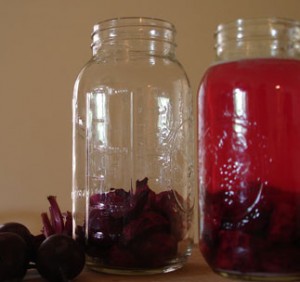
Eat your Beets! Beets have almost gained the same status in the kitchen and on the plate as kale has in recent times. It wasn’t long ago that beets were not well appreciated but now most folks can’t get enough of the deep red color cooked or raw, they fly off the shelves.
Beets have traditionally been considered as curative, restorative and strengthening. They contain a natural sugar in a balanced proportion, making them a real pleasure to eat! They are a good store of minerals (including iron, copper, zinc, calcium, magnesium, phosphorus, potassium and sodium), trace-elements, antioxidants, betaine and vitamins B & C. Lacto-fermented they are also a source enzymes and pro-biotics.
wikipedia: The usually deep red roots, and sometimes golden-yellow, are eaten either grilled, boiled or roasted as a cooked vegetable, or cold as a salad with vinaigrette (either after cooking, or raw and shredded), or as a condiment (lacto-fermented or pickled in vinegar). The green, leafy portion of the beet is also edible, and has a high carotenoid content (i.e. pro-vitamin A). It is most commonly served boiled or steamed, in which case it has a taste and texture similar to spinach. Eating the beet root and its green leaves together provides an excellent combination, as the sweet beets are a good complement to their bitter greens. Beets are also used to make juice, drank as tonics: fresh juice made with a juicer, or the sour cultured beet kvass juice produced by lacto-fermentation.
The red color compound of the beet is not broken down in the body, and can temporarily cause urine and stool to assume a reddish color. This effect is completely harmless and will subside once the food is out of the system.
Eat your beets & tops on a regular basis, especially through the fall and winter, for their nutritional value, as well their ability to detoxify the body, protect the liver, stimulate the flow of bile, reduce blood pressure, prevent cardio-vascular problems, and improve athletic performances.

Recent Comments